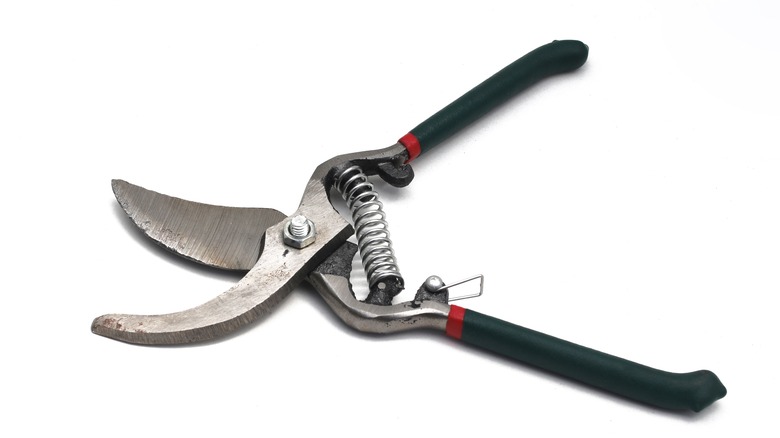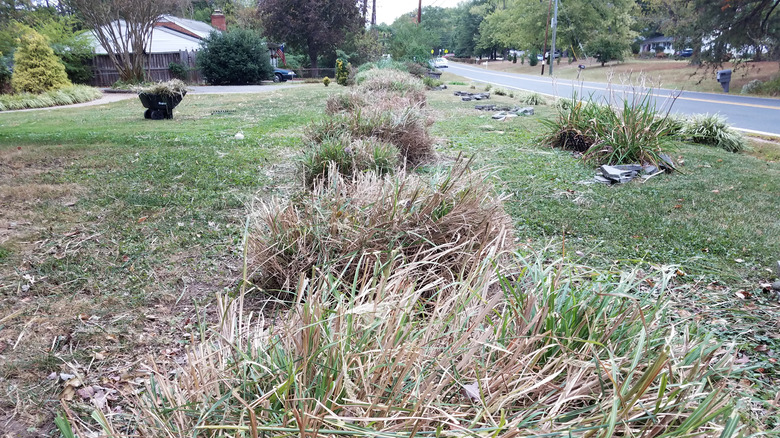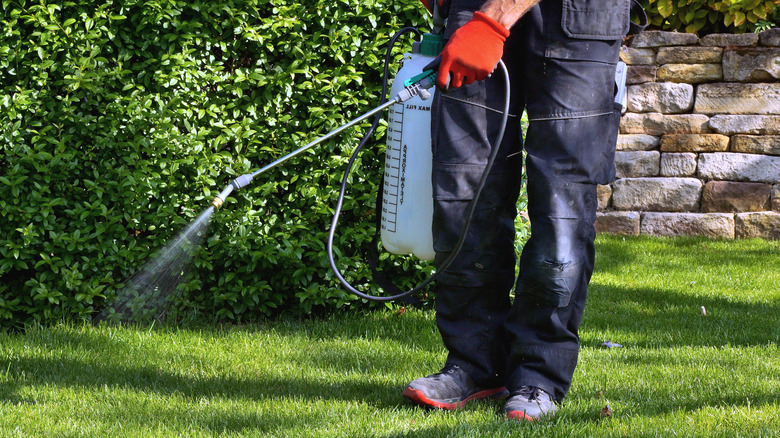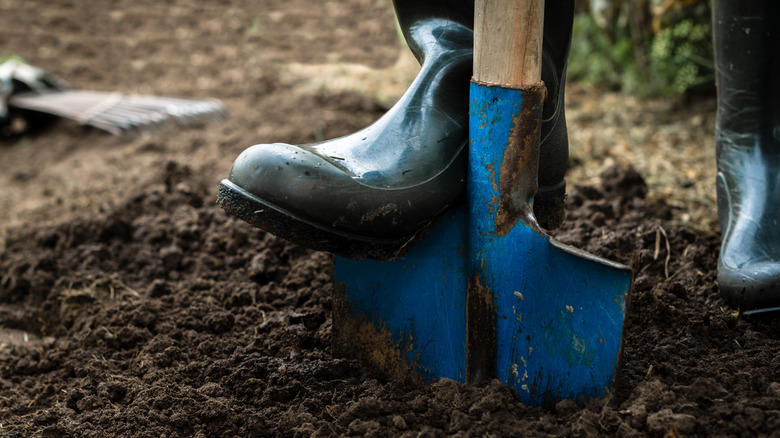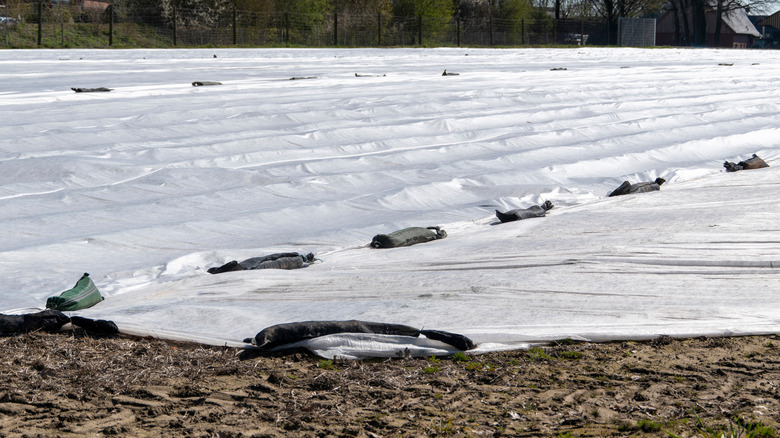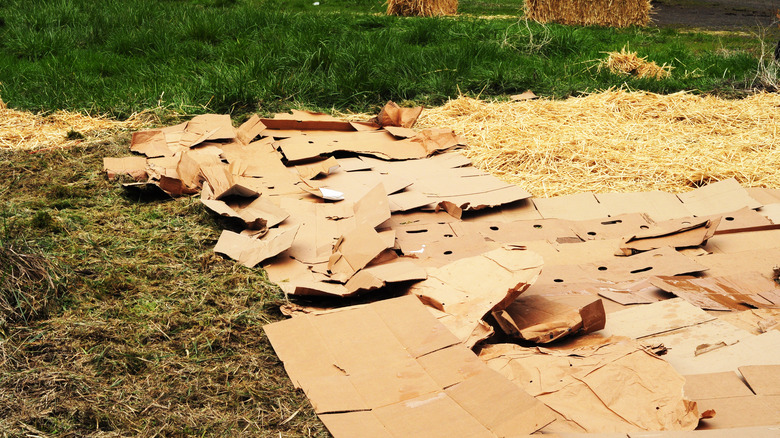8 Best Ways To Get Rid Of Pampas Grass
Pampas grass has been cropping up everywhere. The fluffy flower heads are striking in a mixed bouquet, or on their own, in a sculptural display. Its qualities enhance rustic floral arrangements, and once dried it can last for years. In home décor, it complements a variety of design styles. Outside, Cortaderia selloana is an ornamental and hardy perennial that requires little maintenance and contributes height, texture, and contrast in a border or along fence lines. The plumes catch the slightest breeze, feathery and shimmering atop a slender stalk. Most often blonde to silver, they can be dark rose or rust — a beautiful array in autumn.
Though all of this makes a strong case for adding pampas grass to your landscape, proceed with caution. In some regions it's classified as an invasive species or even illegal to sell. (Visit the USDA for an invasive and prohibited species list by state.) The California Department of Fish and Wildlife explains that invasive plants compete with native species and discourage biodiversity. Specifically, the sharp foliage of pampas grass is an unaccommodating source of shelter or food for animals, and can even be harmful.
If already growing within your garden, you may be experiencing its tendency to crowd out other plantings, block sunlight, or spread rapidly. And according to The Spruce, pampas grass poses a serious fire hazard if located too close to structures or grilling areas. Fortunately, there are effective ways to diminish its spread, or rid your lawn of it completely.
1. Prune pampas grass
Preventing the spread of seeds is one of the best defenses for long-term elimination of a plant, and is an even more urgent undertaking in regard to invasive species. Achieved by snipping the flower heads before the plant self-sows and seeds are transported by wildlife or wind, it's a tedious task but not too physically demanding. Considering the fact that each flower head may contain as many as 100,000 seeds, with the potential distribution miles from their source, it's worth making the effort. Furthermore, HGTV reports that one plant alone produces up to a million seeds throughout its lifecycle.
Simply shear each flower from the stem directly below it with pruners and dispose of them by double-bagging. The blades of the foliage are sharp and serrated, so you'll want to protect your arms, hands, and face during the pruning process. SFGate recommends wearing thick gloves, long sleeves, pants, and safety eyewear as an extra precaution.
Always remove and securely bag flower heads before any involved maintenance to prevent inadvertent spreading of seeds. Landfill disposal is recommended. Protective gear should be worn whenever coming into contact with Cortaderia selloana.
2. Cut pampas grass back
Guidelines for cutting back ornamental grasses found at The Spruce can be applied here as well. Start by collaring groupings of stalks of pampas grass with a bungee cord or wide tape. Landscape tape is formulated to be elastic and gentle on plants, but you won't need it in this instance since the plant is being discarded. Excessively tall bunches may need more than one wrapping. This makes it tidier and easier to see the progress, while allowing a more efficient cutting.
Use shears or hedge trimmers to lob the column off close to the ground, pushing it away as you cut. The experts at Gardening Know How say long-handled pruning tools offer better leverage, and for larger clumps a chain-saw is sometimes necessary. Rake up any errant stems. Once again, bag the removed stalks and deposit the bags in the trash, not the compost or municipal pile.
3. Remove clumps of pampas grass manually
Young plants and those 3 feet or shorter, including some dwarf pampas grass (Cortaderia "Pumila") can be manually pulled from the ground. If small clusters are growing outside of the main tussock, these can be extracted in the same way. Wait until after a rain, when the soil is softened and will release them with less difficulty.
First, explore the area around the base of the stands gently with a rake handle to ensure there are no tiny mammals within the stalks. As above, prune the plumes from each plant, bagging them as you go. Following instructions from SFGate, tug a group of stalks from the ground in a quick and sharp motion, gripping at the base. Try to keep the whole of the root neck (the juncture where the stems emerge from the root) intact, otherwise roots left behind can sprout or germinate, eventually forming a new plant.
4. Apply herbicides to pampas grass
Larger bunches of pampas grass can be cut down using the above method and then carefully treated with a post-emergent herbicide, like glyphosate. Post-emergent simply means it is appropriate for existing plants, vs. pre-emergent, for weed prevention. (Eco Garden Solution does not recommend glyphosate for use in areas near open water, where it can harmfully affect aquatic animals.)
Protect skin and eyes, and wear a respirator when applying herbicides. According to Backyard Workshop, cutting the grass has the added benefit of stimulating new growth, which encourages the roots to absorb nutrients from the soil — in this instance, the plant will be further absorbing the herbicide. SFGate suggests repeated application a week later, and again if needed. Take precautions to avoid contamination of any native or desired plantings, such as covering them with a tarp or cardboard, and not applying sprays on windy days. Finally, always read labels and follow the instructions carefully during herbicide application.
5. Dig pampas grass out
With more insurance than any of the above methods, digging up the roots of pampas grass goes right to the source. But, according to Northern Arizona Invasive Plants, one pampas grass root can cover 1,000 square feet of soil area, and grow 3 meters deep. With some plants towering at almost 20 feet in height it's no wonder they have such far reaching root systems.
You'll want to begin by cutting large bundles of stalks close to the ground, as outlined above. Then, wait for a rain to soften the ground. Several tools will be helpful; use a pickaxe to loosen the roots where they emerge from the dirt, a pointed spade for carving away soil, a long-handled lopper or pruning shears for cutting meandering roots from the root stock, and a shovel. Rocking the root stock back and forth in the ground can facilitate extraction — a good workout. Martha Stewart shares several tips for the removal of deeply rooted plants, including continuous chops through the root system as it becomes visible and retaining an adequate length of stems or limbs for grabbing onto. Properly discard them in the same manner noted previously.
Successful eradication of pampas grass is contingent upon the amount of root system removed, so it's important to be diligent and thorough. Additionally, American Lawns says that filling the resulting holes with new plants helps to discourage regrowth of the pampas grass. FYI, always determine the location of utility lines before digging.
6. Cover pampas grass with plastic
According to Gardening Know How, plants can be killed by covering them with plastic. Called soil solarization, it's an environmentally conscious practice that uses solar energy as weed control. In summer, when temperatures are at their peak, a clear plastic tarp is laid over pampas grass, anchored, and left in place for up to three months. This process creates an intense heating of the soil which kills any plants and organisms beneath it.
The pampas grass must first be removed near the roots. The folks at Texas A&M Agrilife Extension recommend saturating the soil fairly with water, and burying the perimeter of the sheeting to prevent the escape of built-up heat and steam. Further stake or weight the plastic to secure it from wind and animals. The ground under the sheeting may require rewetting several times during soil solarization to maintain the optimal environment. Once the process is complete, the outlet mentions the importance of fortifying the earth in preparation for any new plantings.
7. Cover pampas grass with mulch
In sheet mulching, cardboard is laid over the affected area and topped with mulch, trapping moisture and smothering weeds underneath. Friendlier still to the environment, the cardboard and weeds both eventually break down into the soil. Modern Farmer suggests using the largest sheets available, free of tape or colorful images.
The process for doing this with pampas grass is straightforward: Trim all plants to near ground level, then wet the soil well. Next, lay down the sheets, overlapping them by several inches, and wet the cardboard until saturated. Finally, distribute mulch or finished compost in an even layer at least 2 inches thick.
Compost must be covered with mulch. Optionally, other organic material can be added on top, such as straw or leaves. Allow the sheet mulch to remain in place while it decomposes, and for as long as a year. The soil will need to be loosened in preparation for new planting, but will now be rich with nutrients.
8. Bring in the professionals
Eradication of pampas grass can take years and determination; it's a formidable challenge for even the most knowledgeable gardener. This noxious weed spreads aggressively and quickly, with a deep root system that can span 20 feet laterally. But do you really want to dedicate hours of free time toward its removal?
If not, bring in a lawn care professional to help. They have expertise, manpower, and access to commercial-grade products, and are trained technicians required to follow strict protocol in the application of chemicals. Check with neighborhood groups, garden centers, and friends and family for referrals. Or, consult this article from The Spruce, featuring their top 20 lawn care services throughout the country for 2022. The rankings were determined with several factors, including location coverage, user-friendly sites, customer satisfaction, and cost.
Professionals should undertake a detailed assessment of your yard and create a plan specific to your situation and objectives. Most lawn care companies welcome customer involvement and questions, but they certainly don't require them. And many offer satisfaction guarantees.

